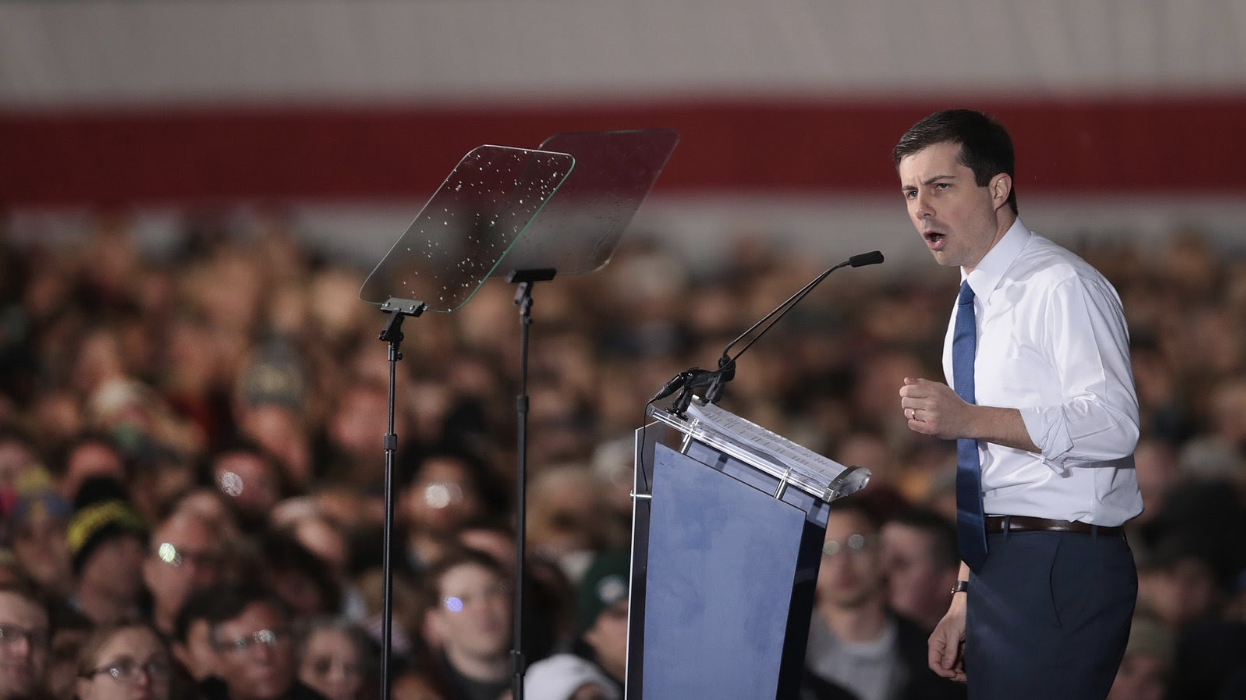
KONNOR VON EMSTER – MARCH 5TH, 2020
EDITOR: SABRINA LERSKIATIPHANICH
Pete Buttigieg, a young veteran and mayor of South Bend Indiana, faced the daunting task of running against established candidates for the Democratic Nomination in an election cycle stirred by one general question: who will be a formidable opponent to Donald J. Trump? Despite these unfavorable odds, Buttigieg proved himself as a moderate candidate and was a frontrunner in the competitive primary election.
Healthcare policy has surfaced as a leading topic this election cycle. Many political voices have harped on the US’s failures to match the care of other developed countries. As part of the series on presidential candidate healthcare plans (Sanders here, Warren here), Buttigieg’s stood out as one of the most comprehensive alternatives to Warren and Sanders’ plans to implement Medicare for All.
A public option would be a health care plan people could opt into as an alternative to private insurance. The general consensus is that such a plan will be cheaper and have greater subsidies, although generally also be more restrictive than private insurance. Unlike single payer health systems, the public option would operate among the current market-based insurance system. Each candidate has their own vision of what a plan like this would entail and what sidecar proposals would be needed to make the plan a success.
Ever since Buttigieg and Klobuchar dropped out of the Democratic primaries, Biden stands as a strong contender in support of the public option. Biden’s plan is very similar to Buttigieg and seeks many of the same policy proposals while varying slightly in tax rates, subsidies, and overall thoroughness. Therefore Buttieig’s public option plan may stand out if the public option is implemented.
While Bernie has run on the statement of “Medicare for All,” Buttigieg added the remarkably free-spirited and American twist “Medicare for All Who Want It.” This centralized the main theme of the bill as a choice, which may have swung some moderates, who saw the expansion of government power present in single payer health care as too great and extraordinarily daunting to pass in the current political climate, into his camp. While the public option plan may have been the center of his rallying cry, other tenants included mental health care reform, rural healthcare reform, and prescription drug price reform. Here is a breakdown of what those proposals looked like and how sound their economic promises were.
Public Option, Subsidies, and ACA strengthening
The public option proposed by Buttigieg stood as an option people could opt into in the marketplace. If they liked their insurance, they could stay with their current private insurance. Those who disliked their employee healthcare plan or private insurance would have a choice to opt in, as the public option was set to be a more affordable, albeit restrictive option, than private insurance.
Expanded access was a top priority of Buttigieg’s. Therefore, he planned on subsidizing coverage to lower and middle class families for which insurance was still too expensive, even at the low marginal cost of the public plan. Specifically, he had committed to capping premium payments at 8.5% of income, presumably giving people an affordable option for care. Another key tenant under his plan was that those with lower incomes who did not fall under Medicaid but would still receive substantial subsidies or free insurance would be auto-enrolled in the public option. Auto-enrollment is a powerful tool, as people often stick with their default option as seen in the random enrollment period after Medicare Part D.
Important for an older demographic of voters was Buttigieg’s plan to make healthcare affordable for seniors by capping out of pocket expenses. This, along with ending surprise billing, would help Americans project what their future medical costs would be with greater accuracy.
The debate between a public option and single payer has been at the forefront of debate this election cycle as values further distinguish the moderate Democrats—Biden, Buttigieg, and Klobuchar—from the democratic socialists like Warren and Sanders. In the public option camp, free-will reigns supreme. In the Medicare for All camp, the rallying cry is that healthcare is a human right rather than a luxury. The latter mindset has been criticized for the tax hikes required to implement a bill that would essentially publicize an industry that takes up 18% of the US economy.
Buttigieg was cognizant of the potential for failure in a marketplace solution for healthcare–as the failure of the ACA exemplified–stating that the public option in Medicare’s expansion to a greater number of people could naturally lead to single payer. For moderates unsure about diving in for universal health care, the public option would, arguably, be a stepping stone to a stronger, more robust national healthcare system.
By not eliminating the insurance industry entirely, the public option has been criticized for its ability to save on administrative costs and its role as bargaining power against pharmaceutical companies. Instead of a unified nation negotiating prices with big pharma, only the Medicare block would be able to. This undoubtedly represents a formidable bargaining force, although not as powerful as the former. On the other hand, this would also be a protective measure for small pharmaceutical companies over the monopsonistic power of the single payer healthcare system. Companies that cannot sustain themselves at Medicare prices would still be able to sell to private insurers, meaning that private insurers could offer expensive technologies Medicare would reject, representing a tangible benefit of private insurance over public insurance.
Currently Medicare does not have any health technology assessments, which was an area Buttigieg’s plan could have been improved. Innovative technologies are often too expensive for the public plan to cover, which has been a rising problem with Medicare and Medicaid. This line of discussion always reignites the debate over initiating advisory boards that set cost effectiveness thresholds on what technologies insurers are willing to pay for, often disparagingly called “Death Panels.” The ACA’s Independent Payment Advisory Board (IPAB) was intended to curb medical spending through cost analysis without a clear cutoff for efficacy. Even though Buttigieg had made it clear he wanted to strengthen the ACA and protect its provisions from future attacks, he had not made it clear whether he would bring back IPAB, which was gutted early into Trump’s presidency.
Considering Buttigieg was choosing one of the free-market solutions to public healthcare, it would have been important for him to strengthen the marketplace built by the ACA. His plan stated this would be accomplished by expanding “cost sharing reduction payments” to lower out of pocket costs. His specifics were thin for other places to restore the ACA, although one important benefit would be stating the individual mandate to combat adverse selection.
Financing the bill for a public option is much more attainable than Medicare for All and requires much less complex tax plans to be passed. Buttigieg’s approach simply implied that repealing Trump era corporate tax cuts could easily finance the proposed cost of $1.5 trillion over the next 10 years.
A common argument against the public option is that it will not eliminate the burdensome administrative costs of the private insurance industry due to the cost of claim processing and transactions. Buttigieg vowed to decrease these costs by standardizing all insurance transactions and claims, and also to establish a central clearinghouse for claims. The effect on driving down administration costs was estimated at $100 billion over 10 years.
Mental Health Care, Rural Redevelopment, and Pharmaceutical Negotiations
Buttigieg’s healthcare plan addressed the opioid, addiction, and depression epidemics sweeping the nation. Mental health is clearly an issue that resonates with the American people, and Buttigieg capitalized on this sentiment.
Part of the issue is the lack of attention the insurance industry has given to mental health services, which is why Buttigieg offered Mental Health Parity as a potential solution. Mental Health Parity treats any mental health concern as equal to that of a physical ailment. The goal would be to treat more underlying mental health issues, such as addiction, by changing payment structures to reflect similar co-payment rates, such as physical therapy.
The consequences of such a proposal are vast and uncertain. Such a proposal will undoubtedly increase premiums as more people will take advantage of such services, thus increasing costs for the entire insurance pool. How such parity will be enforced or implemented is also up for questioning as insurers scramble to meet guidelines or risk fines. Parity will need to be specifically defined, with coinsurance and copayment rates set accordingly.
Other proposals by this plan included service options to decrease “deaths of despair” commonly characterized as deaths due to suicide, overdose, or mental health related issues. The proposal included plans for a three digit suicide hotline, free annual mental health checkup, universal medication assisted addiction treatment, and large grants for communities to solve their local mental health crises. The hope was that these resources bookmarked for mental health would have positive externalities as these people could contribute more to the workforce and society at large.
One often misunderstood goal of Buttigieg was the decriminalization of mental illness and addiction. The consequences of mental illness and addiction often involve illegal or disruptive activity, such as psychotic episodes and drug possession. To combat this, Buttigieg planned to decriminalize drug possession and reduce sentencing for crimes commonly perpetrated by the mentally ill, while simultaneously investing in judicial reform and rehabilitation to keep people out of addiction and jail so that they can be contributing members of society. What he ultimately hoped to instigate was a change in mental health discord and social perspective on addiction, mental health, and community strength.
Rural communities are underrepresented for mental health services, which was one of the main topics in Buttigieg’s rural health initiative. Looming concerns for many rural residents include hospital closures, higher-than-average physician costs, and limited health care innovation. The problem is exacerbated by limited incentives for investment, higher risks, and a shortage of doctors, all of which Buttigieg promised to fix.
To combat a doctor shortage, Buttigieg was offering several programs to increase supply. These included expanding the loan forgiveness program to doctors, residency incentives, and immigration offerings for doctors who commit to rural communities. Several innovative approaches included encouraging the expansion of telemedicine (medicine provided by doctors over video conferencing) and increasing the offerings of EMT and Paramedic services.
To slow the closing of more healthcare facilities, Buttigieg promised to use the backstop fund to decrease risk from uncompensated care many rural hospitals need to provide. He also promised to try new models currently being used to finance rural hospitals in Maryland, focus on outpatient service centers, and community leadership of health services. Combined with the mental health services Buttigieg promised, and the proper funding, these programs could have potentially been enough to break the current care gap in these regions.
If all of those three were not enough, Buttigieg even had a plan to stem pharmaceutical costs, one of the major input costs and contributors to high premiums as a whole. His proposal capped out-of-pocket premiums for many income levels while also pursuing negotiations with pharmaceutical companies to decrease their prices. He planned on pressuring affordable prices on these companies using the government bloc as a collective bargaining unit across Medicare, Medicaid, and public option plans.
In addition, Pharma companies that refused to lower their prices could be subject to having their patents broken, giving way for generic manufacturing. Increased competition through greater generic manufacturing and biosimilars would drive down specific costs. Companies that use their patent advantage to raise prices by more than inflation were also proposed to be penalized.
In efforts to restore the free market, Buttigieg also proposed establishing consistent drug pricing by publishing Medicare spending, while also mandating hospitals publish their fee structures as well for consumers to view. Both of these would decrease asymmetric information and restore market choice to those looking to receive services from a certain hospital.
Antitrust policies blocking mergers of large healthcare chains were also included in his proposal as a measure to stop increasing prices without better quality of care. This story has repeated itself in many healthcare and non-healthcare mergers when companies merge to form a firm with greater market power than before. While most of them cite decreased administration costs as their end goal, very few have actually realized such gains for their consumers. The rationale states that more competition will ultimately drive companies to higher levels of efficiency.
Feasibility
Feasibility of proposals is always up for debate every election cycle as voters often care about what is realistically going to happen in the coming years. It is no secret that America’s political system is extremely partisan, leading many to question the feasibility of any health care proposal.
If financing is any indication of feasibility, Buttigieg’s plan was much less costly than universal, single-payer healthcare. Instead of the laundry list of tax changes needed to pass for Warren and Sanders plans to be funded (estimated at around $26 trillion over the next decade), Buttigieg’s modestly priced $1.5 trillion plan requiring just the rollback of Trump era corporate tax cuts was much more realistic.
This would have been difficult to pass in a bipartisan congress but was still feasible, especially considering it covered many initiatives people in the Republican block would be interested in, such as healthcare for rural voters and increased Medicare protection. Like the ACA which passed in a bi-partisan congress, Buttigieg was acting in the current market based system and retaining many institutions the Republican block cared about.
Even then, Buttigieg’s plan was very progressive compared to the current healthcare system. There were many social and technological innovations that must have succeeded in order for the benefits alleged by Buttigieg to actually materialize. While some proposals may have involved easy changes, such as integrating doctors into rural areas, it would have been difficult to predict the level of hospital investment in rural towns or telecare adoption among many who have exclusively had doctor interactions face-to-face. In addition, Buttigieg was hoping for major prison and addiction reform, which many people disagreed with ideologically due to fears over drug legalization.
The entire plan would be ineffective if the public option ended up costing the same as or more than private insurance. If there was a low absorption rate of the public plan, the government’s gains from economies of scale would stagnate. Increased requirements on plan quality may have cause insurers to to raise premiums on existing plans, causing dissatisfaction with current buyers. This is what happened with the ACA, and there was no certainty it would not happen with a public option.
Prescription drug cost reductions would be beneficial to decreasing other costs associated with healthcare, although this could not have been the final solution. Without a payment advisory board to limit expense for high cost treatments there would have been little room for premiums to decrease.
Buttigieg may have expected gains from the money invested in mental health, addiction, and prison reform. These issues remove individuals from the labor supply and also take away healthcare resources focused on crisis rather than long-term care. By some estimates, the societal cost of mental illness is in the trillions of dollars, lending some weight to the externalities gained from mental health reform. It also follows that a healthier society will take on less sick days and be in better spirits to be more productive. If people are not spending time on recovery, they can place that time into more economically productive uses.
Mental health parity was also an ambitious goal. Mental health costs would have undoubtedly increased insurance premiums, as they would no longer be paid up front by the consumer. While it may have been intended for social good, the high price tag may have dissatisfied voters and others who would pay much higher premiums as a result.
Finally, Buttigieg’s plan placed a lot of emphasis on standardization of systems to bring down administrative insurance costs. While it is true that central claim processing would decrease costs, there were costs associated with building the standardization system that would have, inevitably, offset the gains. Because it would not eliminate insurance as a whole, other issues in the standardization and transition process might have come up, which would have added uncertainty to the possibility of making up the $10 billion per year Buttigieg expected to save.
Conclusion
Buttigieg’s health care plan brought a new option to a field with many proposals for universal single payer and unspecific plans for healthcare policy. It stood as one of the most complete in the field and cognizant of greater health concerns contributing to general dissatisfaction with the health of the US. While feasibility was up for question, it would have ultimately been up to the American people to decide which plan spoke to their individual needs.
Featured Image Source: The New York Times
Disclaimer: The views published in this journal are those of the individual authors or speakers and do not necessarily reflect the position or policy of Berkeley Economic Review staff, the Undergraduate Economics Association, the UC Berkeley Economics Department and faculty, or the University of California, Berkeley in general.



